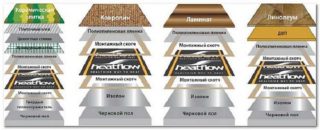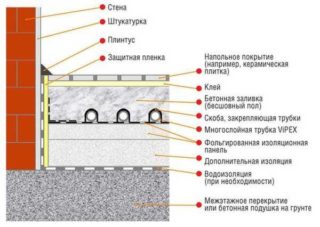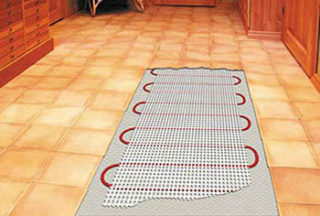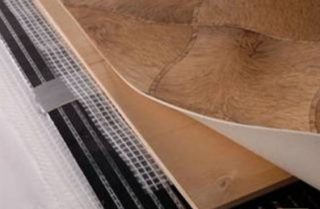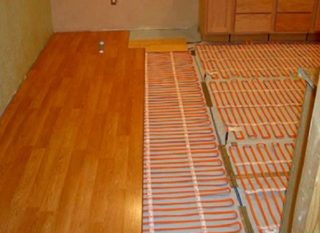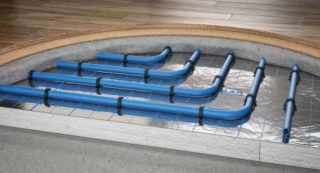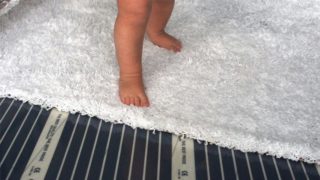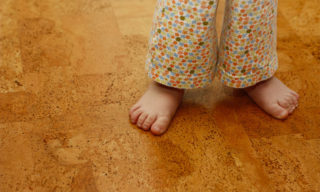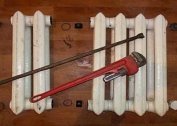Heated housing using an underfloor water circuit is becoming increasingly popular in the private sector and commercial construction. Thanks to the installation of these systems, it is possible to create the most comfortable and safest temperature health regime in the room. To properly close the underfloor heating in the house, you need to consider many aspects associated with the further operation of this design. Properly selected material warms up well, while maintaining the appearance, volume and performance. Before making the optimal decision in all respects regarding the choice of coating for a warm water floor, it is necessary to study the requirements imposed on it, features, pros and cons of the materials on sale.
Coating Performance
In country houses and cottages equipped with autonomous heating, preference is given to water circuits, since these systems consume much less energy than electric ones, safer, eliminating the risk of a critical temperature increase. Provided that the installation is correctly completed and carried out, the structures are reliable and durable. However, pipes embedded in concrete along which hot water runs are only part of the system that is a heat carrier. It still needs to be transferred to the room with minimal loss. To do this, lay the topcoat for a warm water floor.
When choosing a material, the following criteria must be considered:
- Thermal conductivity. This indicator determines the ability of a substance to transfer heat, the rate of its heating and cooling. The higher the coefficient of thermal conductivity, the better the bodies conduct energy through themselves and the less its loss. If the tiles have CT = 1.05, almost all the heat produced by the circuit is transferred to the room. If CT = 0.04, to warm it through, you will need to spend a lot of energy, most of which will absorb the material.
- Coefficient of thermal expansion. It can be zero or reach several percent. When choosing a coating for a warm floor, you need to abandon materials with an index of more than 0.5%. Otherwise, swelling and cracking may occur.
- Environmental Safety. It should be borne in mind that most synthetic coatings change their structure when heated and begin to release substances harmful to human health into the air. Such floorings must be resolutely discarded.
- Mounting method. If the work will be done with your own hands, you need to assess your strengths and capabilities before you take it. If a choice is made in favor of a film heater, it is advisable to choose a collapsible coating option.
When choosing a cover for a warm water floor, it is necessary to take into account all the nuances in order to ultimately achieve an optimal result in all respects.
Floor heating technology
The warm floor is a multi-layer structure, where each level has its own task.
This design consists of materials that are usually laid in the following sequence:
- Waterproofing. Designed to protect against moisture coming from below and from possible leaks. Coating and roll materials are used.
- Thermal insulation. The energy of the circuit should go up, and not into the floor slab, which is the basis for the pipes. Hard plates or prefabricated shaped blocks with grooves pre-cut for communication are used.
- Water circuit. It is made of iron, copper and metal-plastic pipes.Depending on the size and configuration of the communication room, they place it in a spiral or snake. In one room can be one or more circuits.
- Screed. It is poured with concrete mortar 3-5 cm thick. Inside it contains a reinforcing cage to give the plate strength and resistance to deformation.
- Topcoat. It performs the function of transferring thermal energy and decorative parts of the interior.
The technology of manufacturing a warm floor is the same for all types of rooms. The difference is only in surface cladding.
Mounting Materials
Each apartment and private house consists of rooms that differ in purpose and operating conditions. Before laying the topcoat on a warm floor, you need to evaluate the humidity, patency and style of the room. If ceramics are perfect for the kitchen, not everyone will decide to put it in the bedroom. Nevertheless, if you wish and perseverance, you can find a great solution for any circumstances. To do this, you need to familiarize yourself with the intricacies of choosing a topcoat.
Tile
Porcelain stoneware, glass and ceramics are on sale. There are options for classic styling, pattern and mosaic. The tile is laid on a special waterproof adhesive based on cement. The solution layer with a thickness of up to 3 mm practically does not affect the performance of the coating.
Advantages of the material:
- strength;
- wear resistance;
- the highest thermal conductivity compared to other finishes;
- attractive appearance;
- durability;
- environmental Safety;
- water tightness;
- immunity to fungus and mold;
- resistance to temperature extremes, low coefficient of thermal expansion;
- wide selection of colors and textures;
- ease of cleaning from dirt.
Tiles have cons. The coating is slippery, it can fall on it even if it is dry. In addition, ceramics and glue create an additional load on the supporting structures.
Not everyone likes tiles in the nursery and living room. You can solve the problem with visual perception if you lay texture material that imitates natural wood.
Linoleum
This option is very popular among owners of budget housing. Linoleum is laid directly on the concrete base and fixed on it with special glue. For topcoat, rolls without a thermal insulation substrate should be purchased. It is advisable to choose coatings made from natural raw materials (marmoleums) or PVC, which do not emit harmful substances.
Advantages of the material:
- large selection of sizes and patterns;
- affordable cost;
- ease of installation;
- water resistant.
The main disadvantage is that linoleum is easy to tear with a hard and sharp object. Even a small amount of moisture makes the coating slippery. Solvent accidentally spilled onto the floor will stain it.
Laminate
For laying on a warm base, it is necessary to use a laminate specially designed for such purposes. The coating thickness should not exceed 8-10 mm. Such a product has a marking indicating its ability to withstand temperature extremes.
Material Advantages:
- good thermal conductivity;
- presentability;
- ecological purity of quality products;
- simplicity of laying;
- the possibility of dismantling.
Laminate is afraid of water. The price of goods from a trusted manufacturer can not be called affordable.
Parquet board, parquet
It is advisable to lay wooden parquet on an infrared film, since a natural substance does not allow heat to pass through well.If it is impossible to refuse such a coating, you should choose products made from dense varieties of wood.
The board as a topcoat has the following advantages:
- presentable appearance;
- ecological cleanliness;
- pleasant sensations when touched;
- simplicity of laying.
The disadvantage of parquet is that it does not tolerate changes in temperature and humidity. Based on this, significant costs arise for the acquisition of expensive and high-quality coverage.
Carpet
The decision to cover with a carpet will pay off if it will lie as a finish on a rough wooden floor. Laying on a concrete base is not desirable - thick material is soft, but absorbs heat, thin conducts it well, but walking on such a coating is tough and uncomfortable.
Advantages of carpet:
- affordable price;
- a large selection of texture and composition;
- simplicity of laying;
- resistance to dampness;
- nice view.
It should be borne in mind that cleaning carpet, especially wet, is associated with a certain complexity. To warm it, you need to spend a lot of energy.
Cork
Cork is a practical building material that combines the functions of decorative finishes and heat insulators. The second criterion must be considered when choosing this kind of flooring.
Advantages of cork:
- ecological cleanliness;
- presentability;
- resistance to dampness;
- durability;
- simplicity of laying;
- lack of thermal expansion.
Given the low thermal conductivity of the cork, a coating of a thickness of not more than 4 mm is allowed to lay on a concrete base. It should be borne in mind that such a finish is easily damaged by hard and sharp objects.
Calculations of the selected room
The calculation of the power of the water floor is done with reference to the selected finish coating. The parameters generated by the temperature circuit must correspond to the thermal conductivity of the upper finish. A minimum power of 300 W / m² of flooring is required for cork. To warm up linoleum qualitatively, 120-150 W / m² is enough. When using wooden parquet to achieve comfortable conditions, a power of at least 300 W / m² is needed. The least energy is required for tiles - only 100 W / m².
The optimal choice is the combined use of all types of coating for the arrangement of premises for various purposes. This will allow you to achieve a combination of the optimal level of comfort, coziness and style.
